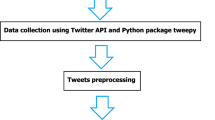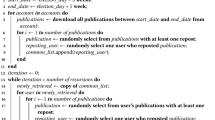Abstract
In today’s interconnected world, online social networks play a pivotal role in facilitating global communication. These platforms often host discussions on contentious topics such as climate change, vaccines, and war, leading to the formation of two distinct groups: deniers and believers. Understanding the characteristics of these groups is crucial for predicting information flow and managing the diffusion of information. Moreover, such understanding can enhance machine learning algorithms designed to automatically detect these groups, thereby contributing to the development of strategies to curb the spread of disinformation, including fake news and rumors. In this study, we employ social network analysis measures to extract the characteristics of these groups, conducting experiments on three large-scale datasets of over 22 million tweets. Our findings indicate that, based on network science measures, the denier (anti) group exhibits greater coherence than the believer (pro) group.











Similar content being viewed by others
Data availability statement
The data and codes used and/or analyzed during the current study available from the corresponding author on request.
References
Germani, F., & Biller-Andorno, N. (2021). The anti-vaccination infodemic on social media: A behavioral analysis. PLoS ONE, 16, e0247642.
Jemielniak, D., & Krempovych, Y. (2021). An analysis of AstraZeneca COVID-19 vaccine misinformation and fear mongering on twitter. Public Health, 200, 4–6.
Neff, T., Kaiser, J., Pasquetto, I., Jemielniak, D., Dimitrakopoulou, D., Grayson, S., Gyenes, N., Ricaurte, P., Ruiz-Soler, J., & Zhang, A. (2021). Vaccine hesitancy in online spaces: A scoping review of the research literature, 2000–2020. Harvard Kennedy School Misinformation Review. https://doi.org/10.37016/mr-2020-82
Khaldarova, I., & Pantti, M. (2016). Fake news (pp. 891–901). Journalism Practice.
McIntyre, L. (2022). How to talk to a science denier: conversations with flat Earthers, climate deniers, and others who defy reason. MIT Press.
Marques, M. D., Kerr, J. R., Williams, M. N., Ling, M., & McLennan, J. (2021). Associations between conspiracism and the rejection of scientific innovations. Public understanding of science, 30, 854–867.
McDevitt, M., Parks, P., Stalker, J., Lerner, K., Benn, J., & Hwang, T. (2018). Anti-intellectualism among US students in journalism and mass communication: A cultural perspective. Journalism, 19, 782–799.
Okruszek, Ł, Piejka, A., Banasik-Jemielniak, N., & Jemielniak, D. (2022). Climate change, vaccines, GMO: The N400 effect as a marker of attitudes toward scientific issues. PLoS ONE, 17, e0273346.
Walter, S., Brüggemann, M., & Engesser, S. (2018). Echo chambers of denial: explaining user comments on climate change. Environmental Communication, 12, 204–217.
van Eck, C. W., Mulder, B. C., & van der Linden, S. (2021). Echo chamber effects in the climate change blogosphere. Environmental Communication, 15, 145–152.
Erlich, A., & Garner, C. (2023). Is pro-Kremlin disinformation effective? Evidence from Ukraine. The International Journal of Press/Politics, 28, 5–28.
Moy, Wesley R., Kacper Gradon, & Russian Covid- Effects. (2023). COVID -19 effects and Russian disinformation campaigns. https://www.hsaj.org/resources/uploads/2020/12/hsaj_Covid192020_COVID19EffectsRussianDisinformationCampaigns.pdf. Accessed June 26.
Nowak, B. M., Miedziarek, C., Pełczyński, S., & Rzymski, P. (2021). Misinformation, fears and adherence to preventive measures during the early phase of COVID-19 pandemic: A cross-sectional study in Poland. International journal of environmental research and public health. https://doi.org/10.3390/ijerph182212266
Jiang, B., Mansooreh K., Lu C., Black T., & Liu H. (2021). Mechanisms and attributes of echo chambers in social media.
Alatawi, F., Cheng L., Tahir A., Karami M., Jiang B., Black T., & Liu H. (2021). A Survey on echo chambers on social media: description, detection and mitigation.
Chay, S., & Sasaki, N. (2011). Using online tools to assess public responses to climate change mitigation policies in Japan. Future Internet, 3, 117–129.
Auer, M. R., Zhang, Y., & Lee, P. (2014). The potential of microblogs for the study of public perceptions of climate change. Wiley interdisciplinary reviews: Climate change, 5, 291–296.
Pearce, W., Holmberg, K., Hellsten, I., & Nerlich, B. (2014). Climate change on Twitter: Topics, communities and conversations about the 2013 IPCC Working Group 1 report. PLoS ONE, 9, e94785.
Williams, H. T. P., McMurray, J. R., Kurz, T., & Hugo Lambert, F. (2015). Network analysis reveals open forums and echo chambers in social media discussions of climate change. Global environmental change: Human and policy dimensions, 32, 126–138.
Holme, P., & Rocha J. C. (2021). Networks of climate change: Connecting causes and consequences. arXiv [physics.soc-ph]. arXiv.
Baumann, F., Lorenz-Spreen, P., Sokolov, I. M., & Starnini, M. (2020). Modeling echo chambers and polarization dynamics in social networks. Physical Review Letters, 124, 048301.
Tyagi, A., Babcock M., Carley K. M., & Sicker D. C. (2020). Polarizing tweets on climate change. In Social, cultural, and behavioral modeling, (pp. 107–117) Springer International Publishing.
Neff, T., & Jemielniak, D. (2022). How do transnational public spheres emerge? Comparing news and social media networks during the Madrid climate talks. New Media & Society, 26, 2066–2091.
Cody, E. M., Reagan, A. J., Mitchell, L., Dodds, P. S., & Danforth, C. M. (2015). Climate change sentiment on twitter: An unsolicited public opinion poll. PLoS ONE, 10, e0136092.
Cinelli, M., De Francisci Morales G., Galeazzi A., Quattrociocchi W. & Starnini M. (2021). The echo chamber effect on social media. In Proceedings of the national academy of sciences of the United States of America, 118. https://doi.org/10.1073/pnas.2023301118
Jasny, L., & Fisher, D. R. (2019). Echo chambers in climate science. Environmental Research Communications, 1, 101003.
Samantray, A., & Pin, P. (2019). Credibility of climate change denial in social media. Palgrave Communications, 5, 1–8.
Littman, J., & Wrubel, L. (2019). Climate change tweets Ids. Harvard Dataverse. https://doi.org/10.7910/DVN/5QCCUU
Documenting the Now. (2020). Hydrator (version 0.0.11).
Van Rossum, G., & Drake F. L. (2009). Python 3 reference manual createSpace.
Peixoto, Tiago P. (2014). The graph-tool python library. Figshare.
Bastian, M., Heymann S., Jacomy M. (2009). Gephi: an open source software for exploring and manipulating networks. In Third international AAAI conference on weblogs and social media.
Berahmand, K., Bouyer, A., & Samadi, N. (2019). A new local and multidimensional ranking measure to detect spreaders in social networks. Computing, 101, 1711–1733.
Salavati, C., Abdollahpouri, A., & Manbari, Z. (2019). Ranking nodes in complex networks based on local structure and improving closeness centrality. Neurocomputing, 336, 36–45.
Rui, X., Meng, F., Wang, Z., & Yuan, G. (2019). A reversed node ranking approach for influence maximization in social networks. Applied Intelligence, 49, 2684–2698.
Wen, T., & Deng, Y. (2020). Identification of influencers in complex networks by local information dimensionality. Information sciences, 512, 549–562.
Chen, Z. (2019). An agent-based model for information diffusion over online social networks. Papers in Applied Geography, 5, 77–97.
Liu, L., Bo, Qu., Chen, B., Hanjalic, A., & Wang, H. (2018). Modelling of information diffusion on social networks with applications to WeChat. Physica A: Statistical Mechanics and its Applications, 496, 318–329.
Wilson, C., Sala, A., Puttaswamy, K. P. N., & Zhao, B. Y. (2012). Beyond social graphs: User interactions in online Social networks and their implications. ACM Transactions on the Web. https://doi.org/10.1145/2382616.2382620
Mislove, Alan, Massimiliano Marcon, Krishna P. Gummadi, Peter Druschel, and Bobby Bhattacharjee. 2007. Measurement and analysis of online social networks. In Proceedings of the ACM SIGCOMM Internet Measurement Conference, (pp. 29–42) IMC.
Newman, M. E. J., & Girvan, M. (2003). Finding and evaluating community structure in networks. Physics Review, 69, 1–16.
Allcott, H., Karlan, D., Möbius, M. M., Rosenblat, T. S., & Szeidl, A. (2007). Community size and network closure. The American economic review, 97, 80–85.
R: Measures of network closure. (2023). https://search.r-project.org/CRAN/refmans/migraph/html/closure.html. Accessed June 20.
Himelboim, I. (2017). Social network analysis (Social Media). In J. Matthes, C. S. Davis, & R. F. Potter (Eds.), The International Encyclopedia of Communication Research Methods (pp. 1–15). John Wiley & Sons. https://doi.org/10.1002/9781118901731.iecrm0236
Santoro, N., Quattrociocchi W., Flocchini P., Casteigts A., & Amblard F. (2011). Time-varying graphs and social network analysis: Temporal indicators and metrics. In AISB 2011: Social networks and multiagent systems, (pp. 33–38).
Milo, R., Shen-Orr, S., Itzkovitz, S., Kashtan, N., Chklovskii, D., & Alon, U. (2002). Network motifs: Simple building blocks of complex networks. Science, 298, 824–827.
Bulmer, M. G. (1979). Principles of Statistics. Courier Corporation.
igraph R manual pages. (2023). https://igraph.org/r/html/1.3.4/transitivity.html. Accessed June 24.
Funding
This work was supported by Narodowe Centrum Nauki (National Science Centre, Poland) under Grant 2020/38/A/HS6/00066.
Author information
Authors and Affiliations
Corresponding author
Ethics declarations
Conflict of interest
The authors have no relevant financial or non-financial interests to disclose. The authors have no conflicts of interest to declare that are relevant to the content of this article.
Ethics approval
The authors declare that there is no any human, animals or live human cells involved in the study.
Additional information
Publisher's Note
Springer Nature remains neutral with regard to jurisdictional claims in published maps and institutional affiliations.
Rights and permissions
Springer Nature or its licensor (e.g. a society or other partner) holds exclusive rights to this article under a publishing agreement with the author(s) or other rightsholder(s); author self-archiving of the accepted manuscript version of this article is solely governed by the terms of such publishing agreement and applicable law.
About this article
Cite this article
Mahmoudi, A., Jemielniak, D. & Ciechanowski, L. Characteristics of two polarized groups in online social networks’ controversial discourse. J Comput Soc Sc 8, 22 (2025). https://doi.org/10.1007/s42001-024-00350-y
Received:
Accepted:
Published:
DOI: https://doi.org/10.1007/s42001-024-00350-y




